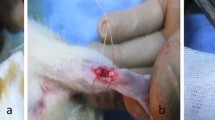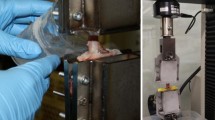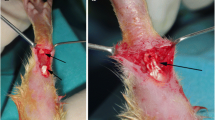Abstract.
Quinolones are antibacterial agents that have the potential to induce Achilles tendon disorders – such as tendinitis or even ruptures – in patients treated with these drugs. We studied the effects of ciprofloxacin on several proteins of Achilles tendons from immature dogs, 10- to 11-weeks-old. The dogs were treated orally for 5 days with 30 or 200 mg ciprofloxacin/kg body weight or with the vehicle alone. Since quinolone-like alterations in joint cartilage were observed in magnesium-deficient animals, another group was fed a magnesium-deficient diet for 6 weeks. At necropsy, tendons (n=3 from each group) were frozen and stored until analysis when they were homogenized in a lysis buffer to release a soluble fraction of the tendon proteins. Densitometric analysis of the immunoblots with anti-collagen type I, anti-elastin, anti-fibronectin, and anti-integrin antibodies showed a significant reduction of all proteins. For example, collagen type I concentrations (mean ±SD, arbitrary densitometric units) were 3190±217 (controls), 1890±468 (30 mg/kg), 1695±135 (200 mg/kg) and 2053±491 in the magnesium-deficient dogs. The differences between concentrations in controls and all treated groups were statistically significant (P<0.01, t-test). Similarly, compared with control samples, relative concentrations of other proteins in tendons from ciprofloxacin-treated dogs (30 mg/kg) decreased by 73% (elastin), 88% (fibronectin), and 96% (β1 integrin) (data from low-dose group only). A very similar pattern of protein alterations was detected in samples from magnesium-deficient dogs. In conclusion, rather low doses of a fluoroquinolone or a diet-induced magnesium deficiency caused similar biochemical alterations in the soluble fraction of proteins from canine tendons. These findings support our hypothesis that quinolone-induced toxic effects on connective tissue structures are due to the magnesium-antagonistic effects of these antibacterial agents. They also indicate that patients with a latent magnesium deficiency could be at an increased risk of quinolone-induced tendon disorders.
Similar content being viewed by others
Author information
Authors and Affiliations
Additional information
Electronic Publication
Rights and permissions
About this article
Cite this article
Shakibaei, M., de Souza, P., van Sickle, D. et al. Biochemical changes in Achilles tendon from juvenile dogs after treatment with ciprofloxacin or feeding a magnesium-deficient diet. Arch Toxicol 75, 369–374 (2001). https://doi.org/10.1007/s002040100243
Received:
Accepted:
Issue Date:
DOI: https://doi.org/10.1007/s002040100243




